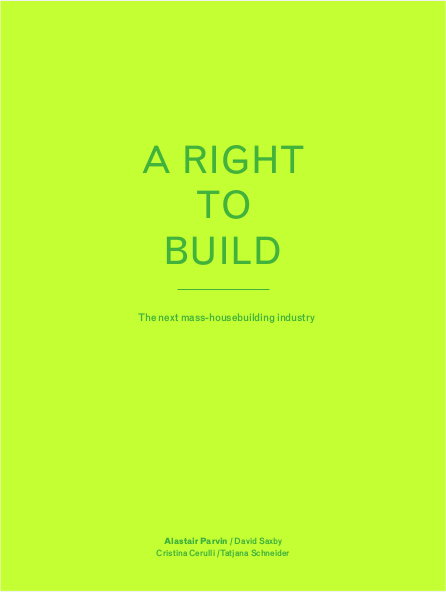A right to build: An open approach to housing provision: self-provision
A right to build is a booklet written by Alaistair Parvin of (00 and Wikihouse), David Saxby, Cristina Cerulli and Tatjana Schneider that outlines a clear and comprehensive vision for how a self-provision approach to housing could be the best way to tackle the UK housing crisis while delivering higher quality, higher performance low energy housing.
Its a deeply inspiring vision of the potential power that empowering, distributive, open ways of doing things, that gives us all agency, to participate in solving problems like climate change can have.
'A right to build' starts by making an observation that we have become accustomed to an assumption that progress in production is the expansion of mass-produced goods, built by professionals and mass-consumed by citizens, a legacy of the industrial revolution, but far from progress the report provides a strong case that the large house builder model has actually resulted in a deterioration in the quality of housing when measured against modern examples of self-provision and self-build.
Driven by a combination of massive house price inflation over the last 40 years and the associated treatment of homes increasingly as financial assets, the incentives for higher quality housing has been sidelined with financial values being pursued over use value.
Who should build?
“The question is not ‘What homes do we need?, but rather ‘Who should build them?’ “ - A right to build.
Self-provision
Self provision of housing is a spectrum of models, the most common characteristic is that the first owners act as the client commissioning their own home. Beyond this there is a varying degree of involvement. From contracting out all of the work or doing a lot of the work yourself (self-build).
Advantages to self-provision:
Self provision fundamentally transforms the kind of houses and neighbourhoods that get built:
- Designed for long term use-value, higher quality: affordability, generosity, sustainability, flexibility, community. Form of production that is structured around valuing those things.
- Increased affordability. Overall cost often a third less and can be even less if you use your own 'sweat equity' (do a proportion of the building work yourself).
- More innovative, more likely to explore more innovate architectural styles and newer and higher performing low energy building materials. More likely to create spaces that lead to further innovation: workshops, garages.
Removing barriers to participation
“The most challenging, but most crucial aspect of scaling the self-provided housing sector is not just increasing capacity for the current self-providing demographic, but coming up with innovative models which lower the economic threshold for participation.”
It mentions the Walter Segal system for self-build conceived in the 1960s and 1970s which is one historical example of an attempt to do this.
- Used an affordable, widely available and easy-to- work with material: timber.
- Lowered the skill-threshold for self-builders. With a bit of basic training and common sense, even those who didn’t have mainstream construction skills could put together a Walter Segal house.
Towards the end of the report a very good point is made about the mistaken attitude and opportunity lost that often classifies the professional-citizen relationship:
“Thirdly, by treating citizens only as passive users of a finished commodity provided by professionals, it can actually decrease the usefulness and quality of that commodity (as this booklet has argued in the case of housing) and decrease also the self-reliance and mutual support within communities. Citizens can be treated as passive, rather than active users, and their potential value can be overlooked. As the New Economics Foundation wrote in their 2008 pamphlet on the subject:
“The reason today’s problems seem so intractable is that public services, and technocratic management systems, have become blind to the most valuable resource they possess: their own clients and the neighbourhoods around them. When these assets are ignored or deliberately side-lined, then they atrophy.””
This is arguably one of the key principles of open source which is perhaps one of the clearest definitions of a system that enables this, a phrase commonly found in open source projects is that this project is open for everyone. Its open to everyone to make build, improve, modify, share, learn.
By treating fellow citizens as co-developers, fellow self-providers as equal contributors rather than passive consumers it unlocks this capacity that we all have.
Read the A Right to build here http://issuu.com/alastairparvin/docs/2011_07_06_arighttobuild
Alaistair Parvin's TED talk: http://www.ted.com/talks/alastair_parvin_architecture_for_the_people_by_the_people
Wikihouse: http://wikihouse.cc/ To engage in discussion regarding this post, please post on our Community Forum.
